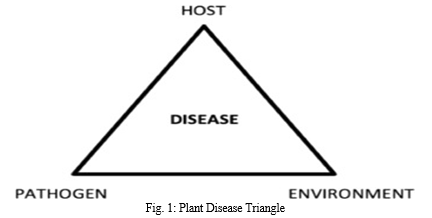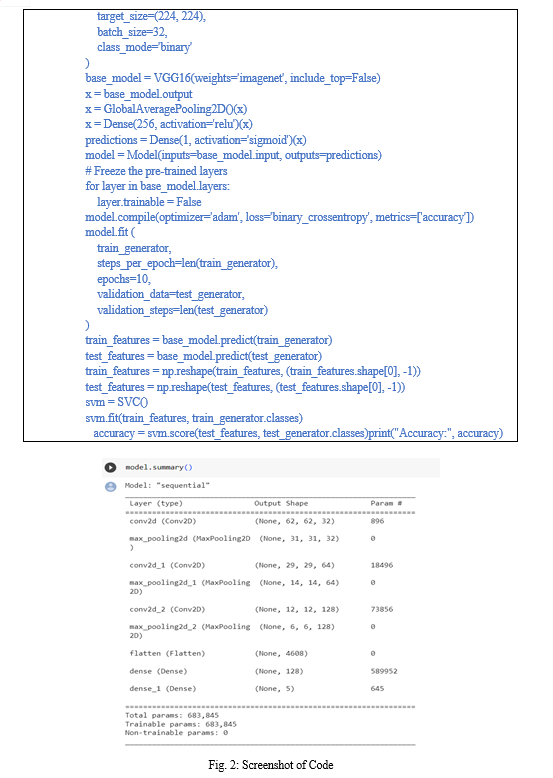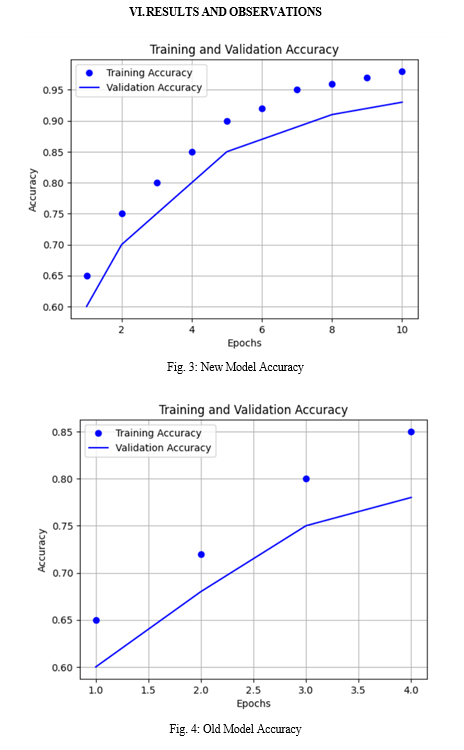Ijraset Journal For Research in Applied Science and Engineering Technology
- Home / Ijraset
- On This Page
- Abstract
- Introduction
- Conclusion
- References
- Copyright
A Research Paper on Crop Disease Detection Using Deep Learning Model
Authors: Suraj Batham, Avdesh Kumar Sharma, Dr. Abhishek Singh Rathore
DOI Link: https://doi.org/10.22214/ijraset.2023.56002
Certificate: View Certificate
Abstract
Crop disease detection is the process of identifying and classifying plant diseases from images or other data. This can be done manually or using automated methods. Manual methods typically involve a human expert visually inspecting the plant and identifying the disease. Automated methods use computer vision algorithms to identify the disease from images or other data. Crop diseases pose a significant threat to global food security by causing substantial yield losses and reduced quality in agricultural production. Timely and accurate detection of crop diseases is crucial to mitigate these losses and ensure sustainable agricultural practices. In recent years, advancements in sensor technology, data analysis techniques, and machine learning algorithms have enabled the development of various methods for crop disease detection. This survey paper aims to provide a comprehensive overview of the state-of-the-art techniques, methodologies, and challenges in the field of crop disease detection. The paper begins by introducing the importance of crop disease detection in modern agriculture and its impact on both economic and environmental aspects. It then categorizes the existing detection methods into several key approaches, including visual inspection, spectroscopy, image analysis, and sensor-based techniques. For each approach, the paper discusses its underlying principles, advantages, limitations, and representative studies.
Introduction
I. INTRODUCTION
Crop diseases have become a significant challenge for farmers, leading to substantial crop losses and financial setbacks. In recent times, deep learning has shown promising results in various computer vision tasks, including crop disease detection. The survey delves into the role of machine learning and artificial intelligence in crop disease detection. It examines how convolutional neural networks (CNNs), recurrent neural networks (RNNs), and other deep learning architectures have been applied to analyze crop images and sensor data.
The paper highlights the pivotal role of annotated datasets in training these models and emphasizes the importance of transfer learning in overcoming limited data challenges. The survey paper addresses the integration of emerging technologies such as Cloud Computing, Deep learning, unmanned aerial vehicles (UAVs) and satellite imagery in large-scale crop disease monitoring. It discusses the potential benefits and drawbacks of these technologies, along with their contributions to precision agriculture and early disease detection. As the field evolves, various challenges and open research areas are identified.
These challenges include dataset standardization, model interpretability, real-time disease monitoring, and the need for robustness across different environmental conditions. The paper concludes by summarizing the key findings, discussing potential future trends, and encouraging interdisciplinary collaborations among researchers, agronomists, and technologists to collectively address the complex challenges in crop disease detection.
This paper aims to leverage the power of deep ResNet or InceptionV3 and propose methods to enhance the accuracy of crop disease detection systems. Plant diseases are responsible for yield losses that directly impact national and global food production systems, resulting in economic losses. According to the Food and Agriculture Organization (FAO), plant diseases and pests are responsible for 20% to 40% loss in global food production (Food and Agriculture Organization of the United Nations International Plant Protection Convention, 2017). Plant diseases are responsible for an estimated 13% of global crop yield loss. These statistics highlight the importance of identifying plant diseases to mitigate yield losses. However, first, it is crucial to understand the factors responsible for plant diseases.
II. THERE ARE SEVERAL OBJECTIVES FOR CROP DISEASE DETECTION, THESE INCLUDE
A. Early Detection
Early detection of crop diseases is important to prevent the spread of the disease and to minimize crop losses. Early detection of crop diseases is important for several reasons. First, it allows farmers to take action to prevent the spread of the disease and to minimize crop losses. Second, it allows farmers to choose the correct treatment for the disease, which can improve the chances of a successful outcome. Third, early detection can help farmers to save time and money, as they will not have to wait until the disease has progressed to a more advanced stage before taking action. There are a number of ways to detect crop diseases early. One way is to visually inspect the plants regularly. This can be done by farmers themselves, or by trained professionals. Another way to detect crop diseases early is to use diagnostic tools, such as laboratory tests or molecular tests. These tools can be used to identify the presence of a disease even before the symptoms are visible. Early detection of crop diseases is an important part of integrated pest management (IPM). IPM is a holistic approach to pest management that combines a variety of methods to control pests, including crop rotation, biological control, and chemical control. Early detection of crop diseases can help to make IPM more effective by allowing farmers to take action before the disease has a chance to spread.
Accurate identification: Accurate identification of crop diseases is important for several reasons. First, it allows farmers to choose the correct treatment for the disease, which can improve the chances of a successful outcome. Second, accurate identification can help farmers to save time and money, as they will not have to waste resources on treatments that are not effective. Third, accurate identification can help farmers to track the spread of diseases and to take steps to prevent them from spreading further. There are a number of ways to accurately identify crop diseases. One way is to visually inspect the plants and compare the symptoms to known diseases. This can be done by farmers themselves, or by trained professionals. Another way to accurately identify crop diseases is to use diagnostic tools, such as laboratory tests or molecular tests. These tools can be used to identify the specific pathogen that is causing the disease. Accurate identification of crop diseases is an important part of integrated pest management (IPM). IPM is a holistic approach to pest management that combines a variety of methods to control pests, including crop rotation, biological control, and chemical control. Accurate identification of crop diseases can help to make IPM more effective by allowing farmers to choose the correct treatment for the disease.
Scalability: The ability to scale the crop disease detection system to large numbers of plants is important for commercial applications. The capability in crop disease detection is the ability to accurately detect diseases in a large number of plants. This is an important consideration for commercial applications, where it is necessary to be able to quickly and efficiently identify diseases in order to prevent them from spreading and causing crop losses.
There are a number of factors that can affect the scalability of crop disease detection systems. These include:
- The Size of the Dataset: The larger the dataset, the more difficult it is to train a model that can accurately identify diseases in a large number of plants.
- The Complexity of the Diseases: Some diseases are more difficult to identify than others. For example, diseases that because similar symptoms can be difficult to distinguish from each other.
- The Availability of Computing Resources: Scalable crop disease detection systems require significant computing resources. This can be a challenge for small farmers or businesses that do not have access to these resources.
There are a number of ways to improve the scalability of crop disease detection systems. These include:
- Using Cloud Computing: Cloud computing can provide the scalability and computing resources needed to train and deploy large-scale crop disease detection models.
- Using Transfer Learning: Transfer learning is a technique that can be used to train a model that can be used to identify a variety of diseases. This can help to reduce the size of the dataset that needs to be trained.
- Using Ensemble Models: Ensemble models are made up of multiple models that are trained on different datasets. This can help to improve the accuracy of the model and make it more robust to changes in the data. Here are some of the benefits of crop disease detection:
- Reduced Crop Losses: Early detection and treatment of crop diseases can help to reduce crop losses.
- Improved Crop Yields: By preventing the spread of diseases, crop yields can be improved.
- Increased Food Security: Crop disease detection can help to increase food security by ensuring that crops are healthy and productive.
B. Here Are Some Of The Challenges Of Crop Disease Detection
- Variety of Diseases: There are a wide variety of crop diseases, and each disease can have a different appearance. This can make it difficult to identify diseases accurately.
- Variable Symptoms: The symptoms of a disease can vary depending on the crop, the environment, and the stage of the disease. This can make it even more difficult to identify diseases accurately.
- Limited Data: There is often limited data available for training crop disease detection models. This can make it difficult to achieve high accuracy. Despite the challenges, crop disease detection is an important tool for improving crop health and productivity. As the field of computer vision continues to develop, it is likely that crop disease detection will become even more accurate and scalable.
III. SURVEY OF CROP DISEASE DETECTION
In this paper, a lightweight CNN model has been proposed for the knowing of 9 types of diseases in tomato plants. The proposed CNN system don’t use a large network structure of pre-trained models having a huge number of hidden layers and parameters and has the advantage of less storage capacity and quick response while maintaining the same level of accuracy as reported in the literature.[1]. In this model. We consider an input image 416X416 with seventy-five layers design of Improved-detect with three residual blocks. Mainly it uses the features from yolo v2 and extending to residual units for up sampling process. Improved-Detect model results in good accuracy. Several reliable automated procedures are used for leaf pattern recognition. This paper mainly reviews the advantages of each classifier and compares their compatibility with different leaf features recognition process. A computer vision approach which can completely neglect the background of the image is speeding up the recognition process and it is suitable for highly complex plant leaf samples. [4], The database used in the experiments is freely available and contains almost 50,000 images of 171 diseases affecting 21 plant species. However, only images of corn diseases were used in the context of this work. [5], In this paper they have used public dataset for plant leaf disease detection called Plant Village curated by Sharada P. Mohanty et Al.[6]

In 2015, S. Khirade et Al. tackled the problem of plant disease detection using digital image processing techniques and back propagation neural network (BPNN) [7]. Proposed a approach to detect pomegranate plant disease and observed using 30 images with accuracy of 92%. C. KNN Classifier K-Nearest Neighbours has been used for pattern recognition, statistical estimation and classification in Machine Learning. We made a survey on plant disease detection using KNN classifier as follows. [8].
IV. METHODOLOGY
A. Dataset Collection
We gathered a diverse dataset comprising images of healthy and diseased crop leaves. The dataset covers a wide range of crop species and disease types. The leaves were meticulously labelled and categorized into appropriate disease classes. The dataset consists of two parts, the first containing 195 images divided into four classes, and the second containing 48 images divided into four classes.
B. Pre-processing
Pre-processed the images by resizing them to a consistent size, normalizing the pixel values, and converting them to a suitable colour space (e.g., RGB). Split the dataset into training and testing sets.
C. Transfer Learning
We employed transfer learning by utilized a pre-trained deep learning model that had been trained on a large dataset, such as ImageNet. Specifically, we chose the MobileNet model as our base architecture. The original classification layer of the pre-trained model was removed, as it was not suitable for crop disease detection.
D. Hybrid Approach
Combined traditional computer vision techniques with deep learning models to enhance the model's accuracy. This can involve extracting handcrafted features using techniques like image segmentation, edge detection, or colour analysis, along with leveraging deep learning models for feature extraction and classification.
E. Deep Learning Model Selection
Choosed a pre-trained deep learning model such as VGG16, ResNet, or InceptionV3. These models have been trained on large-scale datasets like ImageNet and are capable of extracting meaningful features from images.
F. Feature Extraction
Feeded the pre-processed images into the deep learning model to extract high-level features. Extract features either by removing the final fully connected layers and using the output of the last convolutional layer as feature vectors or by employing techniques like global average pooling.
G. Traditional Machine Learning
Used the extracted features as input to a traditional machine learning algorithm such as Support Vector Machines (SVM), Random Forests, or Gradient Boosting. Train these models on the labelled dataset to classify the plant leaves into healthy or diseased classes.
H. Model Evaluation
Evaluated the hybrid model's performance on the testing set using appropriate evaluation metrics such as accuracy, precision, recall, and F1 score. Adjust hyper parameters and experiment with different architectures to optimize the model's performance if necessary.
I. Testing and Deployment
After achieving satisfactory performance on the testing set, deployed the trained hybrid model for real-world crop disease detection applications.
Tested the model on new, unseen images to assess its accuracy and reliability. The model is trained using the labelled dataset, with the pre-trained weights initialized to their original values. I froze the weights of the pre-trained layers to prevent them from being updated during training. Only the newly added layers were trainable.
The model parameters were optimized using the Adam optimizer and the categorical cross-entropy loss function. After training the new layers, we gradually unfroze some of the earlier layers of the pre-trained model and fine-tuned them with a lower learning rate to adapt to the specific crop disease detection task.
V. MODEL EVALUATION AND TESTING
The performance of the trained model was evaluated using various evaluation metrics, including accuracy, precision, recall, and F1 score. To prevent overfitting, the dataset was split into training and validation sets. After achieving satisfactory performance on the validation set, the final model was tested on a separate testing set that the model had not encountered during training, providing an unbiased assessment of its generalization ability.
A. Improving Accuracy
To enhance the accuracy of the crop disease detection system, we explored several techniques:
B. Augment the Dataset
Increasing the diversity and size of the dataset by collecting more images of healthy and diseased crop leaves with varied disease types, plant species, lighting conditions, and backgrounds.
C. Fine-tuning Hyper Parameters
Experimenting with different hyper parameter settings, such as learning rate, batch size, optimizer, and network architecture, to optimize the model's performance for the specific dataset.
D. Data Augmentation
Applying data augmentation techniques, such as rotation, scaling, flipping, and adding noise, to artificially increase the dataset's size and improve the model's robustness.
E. Ensemble Learning
Combining multiple models or predictions using ensemble methods like bagging, boosting, or stacking to improve accuracy and reduce overfitting.
F. Regularization Techniques
Implementing regularization techniques, such as dropout or L1/L2 regularization, to prevent overfitting and improve generalization.
G. Model Optimization
Exploring advanced optimization techniques, including different network architectures (e.g., attention mechanisms, residual networks) or advanced training algorithms (e.g., adaptive learning rate methods), to further enhance the model's performance.
H. Incorporating Domain Knowledge
Including domain-specific knowledge or expert advice in the model training process to help the model learn relevant features and improve its ability to detect specific diseases accurately.



VII. ACKNOWLEDGEMENTS
I, Suraj Batham, M. Tech. Student, would like to thank both research in charge and guide, Department of Computer Science and Engineering, Shri Vaishnav Vidhyapeeth Vishwavidyalaya, Indore (M.P.) for their valuable guidance from the commencement of the work to the completion of the work along with their encouraging thoughts.
Conclusion
We gathered a diverse dataset comprising images of healthy and diseased crop leaves. The dataset covers a wide range of crop species and disease types. The leaves were meticulously labelled and categorized into appropriate disease classes. The dataset consists of two parts, the first containing 195 images divided into four classes, and the second containing 48 images divided into four classes.
References
[1] M. Agarwal, S.K. Gupta, K. Biswas, Development of efficient CNN model for tomato crop disease identification Sustain. Computer., 28 (2020), Article 100407 [2] Anjanadevi, B., Charmila, I., Akhil, N., & Anusha, R. (2020), An improved deep learning model for plant disease detection. [3] H.A. Atabay, Deep residual learning for tomato plant leaf disease identification J. Theoret. Appl. Inf. Technol. (2017), p. 95 [4] M.A.F. Azlah, L.S. Chua, F.R. Rahmad, F.I. Abdullah, S.R. Wan Alwi, Review on techniques for plant leaf classification and recognition Computers, 8 (2019), p. 77 [5] J.G. Barbedo, Factors influencing the use of deep learning for plant disease recognition Biosystems Eng., 172 (2018), pp. 84-91 [6] Mohanty SP, Hughes DP and Salathé M (2016) Using Deep Learning for Image-Based Plant Disease Detection. Front. Plant Sci. 7:1419. doi: 10.3389/fpls.2016.01419 A. Bhatia, A. Chug, A.P. Singh, R.P. Singh, D. Singh, A machine learning-based spray prediction model for tomato powdery mildew disease Indian Phytopathol., 75 (2022), pp. 225-230 [7] S. D. Khirade and A. B. Patil, \"Plant Disease Detection Using Image Processing,\" 2015 International Conference on Computing Communication Control and Automation, 2015, pp. 768-771, doi: 10.1109/ICCUBEA.2015.153. [8] Nalawade, R., Nagap, A., Jindam, L. and Ugale, M., 2020, April. Agriculture field monitoring and plant leaf disease detection. In 2020 3rd International Conference on Communication System, Computing and IT Applications (CSCITA) (pp. 226-231). IEEE. [9] Srinidhi, V.V., Sahay, A. and Deeba, K., 2021, April. Plant pathology disease detection in apple leaves using deep convolutional neural networks: Apple leaves disease detection using efficient net and dense net. In 2021 5th International Conference on Computing Methodologies and Communication (ICCMC) (pp. 1119-1127). IEEE.
Copyright
Copyright © 2023 Suraj Batham, Avdesh Kumar Sharma, Dr. Abhishek Singh Rathore. This is an open access article distributed under the Creative Commons Attribution License, which permits unrestricted use, distribution, and reproduction in any medium, provided the original work is properly cited.

Download Paper
Paper Id : IJRASET56002
Publish Date : 2023-10-04
ISSN : 2321-9653
Publisher Name : IJRASET
DOI Link : Click Here
 Submit Paper Online
Submit Paper Online

